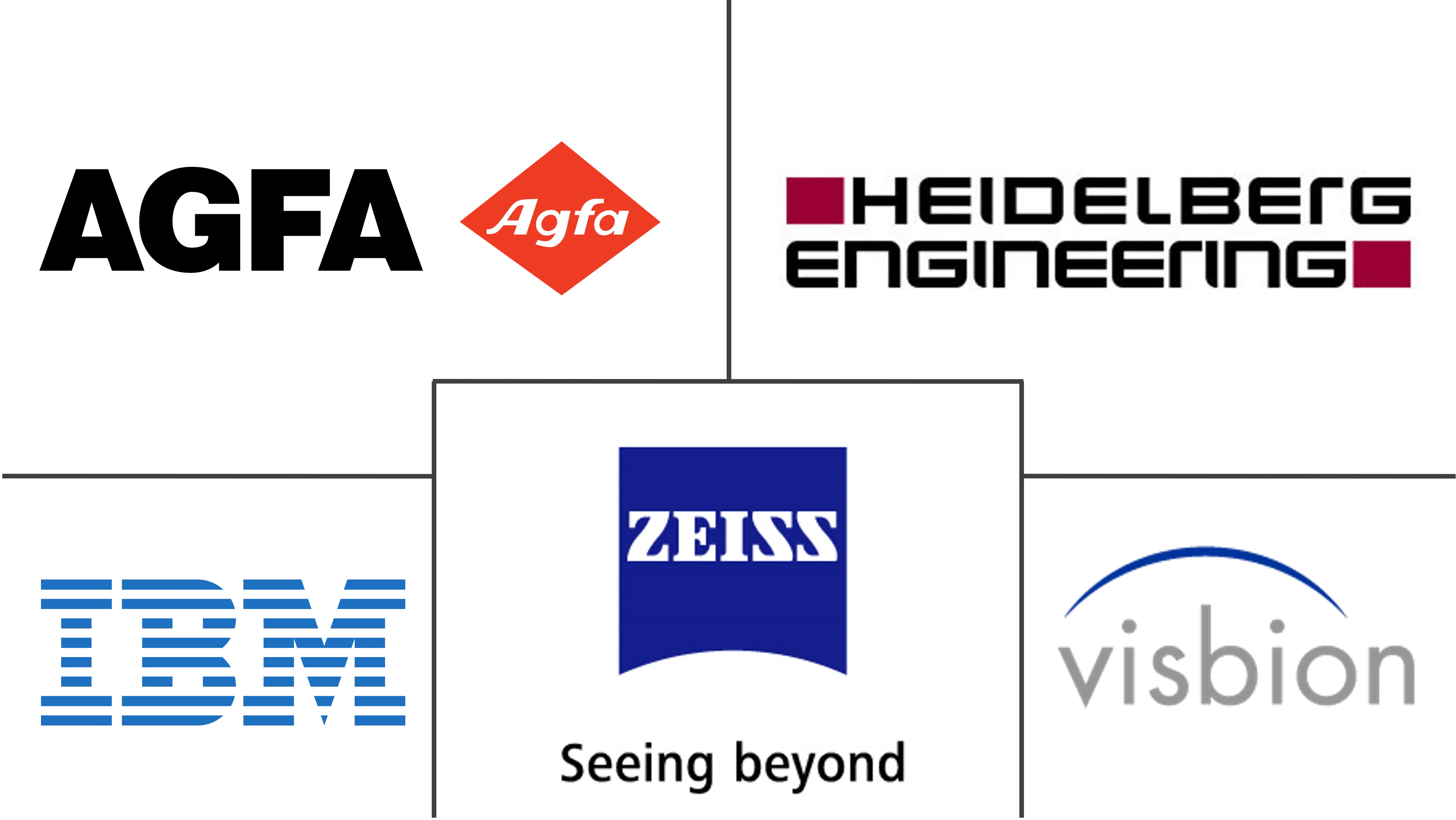Ophthalmology PACS (Picture Archiving And Communication System) Market Size and Share
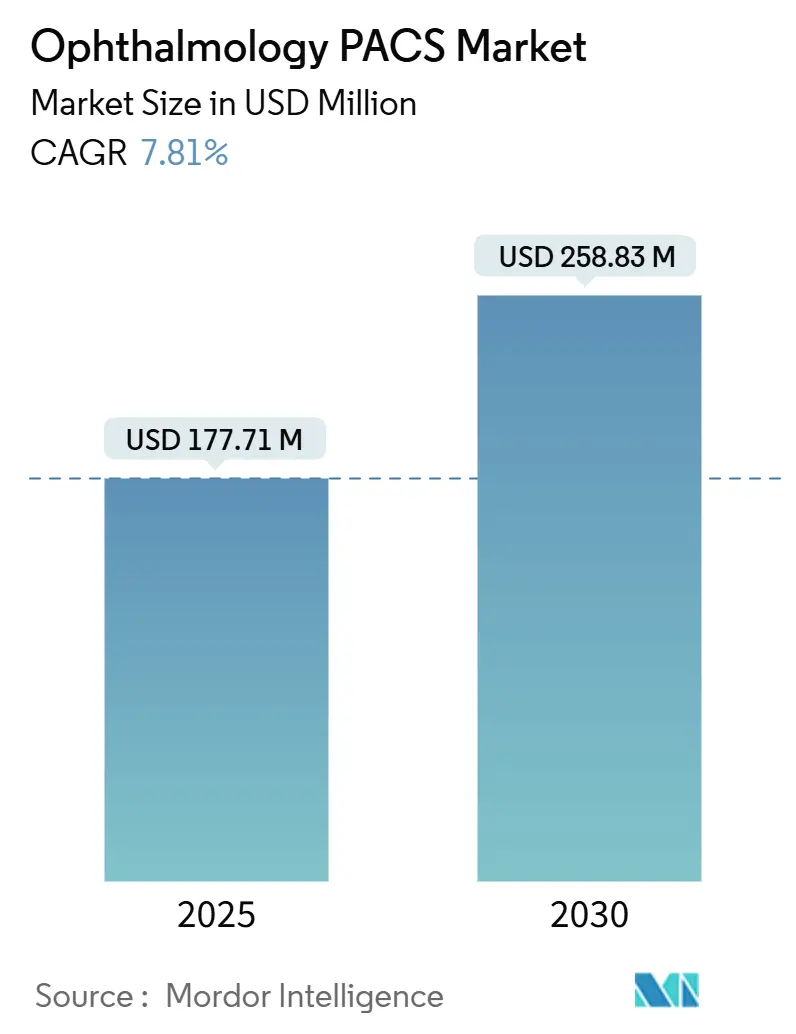
Ophthalmology PACS (Picture Archiving And Communication System) Market Analysis by Mordor Intelligence
The Ophthalmology PACS (Picture Archiving and Communication System) Market size is estimated at USD 177.71 million in 2025, and is expected to reach USD 258.83 million by 2030, at a CAGR of 7.81% during the forecast period (2025-2030). The growing digitization of imaging, the rapid uptake of artificial intelligence tools, and the large pool of elderly and diabetic patients are the primary forces that are expanding the ophthalmology PACS market. Integrated platforms that consolidate acquisition, storage, and analytics functions are replacing siloed, film-based workflows. At the same time, hospital groups and multisite eye-care networks pursue technology that supports value-based reimbursement and tighter clinical governance. Cloud deployment remains the fastest-growing delivery model because subscription pricing lowers capital outlays and simplifies access to AI modules, yet on-premise systems still dominate where data-sovereignty rules and legacy investments prevail. Vendors able to balance security, bandwidth efficiency, and intraoperative OCT integration continue to unlock new efficiencies for clinicians and payers.[1]Source: National Institute of Standards and Technology, “Securing Picture Archiving and Communication System,” nist.gov
Key Report Takeaways
- By PACS type, integrated solutions led with 60.21% revenue share in 2024, and the same segment is forecast to grow at an 8.96% CAGR through 2030, underscoring a preference for single-vendor ecosystems.
- By delivery model, the on-premise segment held 58.95% of the Ophthalmology PACS market share in 2024, while cloud deployments are set to expand at an 8.63% CAGR by 2030.
- By end user, hospitals and eye-care networks accounted for 61.84% share of the Ophthalmology PACS market size in 2024; ambulatory surgical centers are advancing at an 8.22% CAGR through 2030.
- By geography, North America commanded 42.45% revenue share in 2024, while Asia Pacific is projected to record the highest CAGR of 8.51% to 2030.
Global Ophthalmology PACS (Picture Archiving And Communication System) Market Trends and Insights
Drivers Impact Analysis
| Driver | (~) % Impact on CAGR Forecast | Geographic Relevance | Impact Timeline |
|---|---|---|---|
| Rising prevalence of chronic eye diseases | +1.8% | Global, with highest impact in Asia Pacific and aging Western populations | Long term (≥ 4 years) |
| Aging & diabetic population expansion | +1.5% | Global, concentrated in North America, Europe, and urban Asia | Long term (≥ 4 years) |
| Tele-ophthalmology scale-up & home-monitoring | +1.2% | Global, accelerated adoption in rural and underserved regions | Medium term (2-4 years) |
| Shift to AI-enabled cloud PACS lowering TCO | +1.0% | North America & EU leading, APAC following | Medium term (2-4 years) |
| Surgical guidance integration (intra-op OCT feeds) | +0.8% | Advanced healthcare markets: US, Germany, Japan | Medium term (2-4 years) |
| Value-based reimbursement favouring imaging analytics | +0.7% | Primarily North America, expanding to EU | Short term (≤ 2 years) |
| Source: Mordor Intelligence | |||
Rising Prevalence of Chronic Eye Diseases
Global cases of diabetic retinopathy are projected to climb 17.9% by 2030, generating unprecedented imaging volumes that require robust storage and analytics. Modern OCT angiography and fundus systems produce gigabyte-level studies, pushing buyers toward PACS platforms that can rapidly visualize and analyze multilayer datasets. Hospitals link early deployment of such systems with improved outcomes in glaucoma, where earlier intervention prevents irreversible vision loss. Consequently, the ophthalmology PACS market is increasingly viewed as a preventive-care enabler rather than a cost center.
Aging and Diabetic Population Expansion
Adults older than 65 need eye examinations three to four times more often than younger cohorts, and the 4.3 billion-strong Asia Pacific population is aging quickly. Chronic diabetes adds a second demand driver, with the United States spending USD 7.2 billion annually on diabetic eye disease management. PACS solutions that support remote screening allow overextended clinicians to triage and follow higher-risk patients, reinforcing payer incentives that promote preventive imaging.
Tele-ophthalmology Scale-up and Home Monitoring
Virtual vitreoretinal consultations rose 38-fold during 2024 in several health systems, establishing tele-ophthalmology as standard care rather than a pilot service.[2]Source: Journal of Retina and Vitreous, “Virtual vitreoretinal clinics: a service delivery pathway of the future,” biomedcentral.com Home-based OCT devices stream high-resolution imagery that must flow directly into hospital archives. Cloud-native PACS with edge compute features handle intermittent connectivity, letting rural patients receive expert grading without travel. One large public program reported a 43% drop in unnecessary referrals after adding AI triage to its tele-ophthalmology workflow.
Shift to AI-enabled Cloud PACS Lowering TCO
Five-year total cost of ownership for a cloud PACS averages USD 41,250 for centers producing 1,000 studies monthly versus USD 200,000–500,000 for local deployments. Automated positioning checks, quality scoring, and draft reports cut radiologist workloads by up to 40% while improving sensitivity, making AI the differentiator that neutralizes lingering security doubts around cloud adoption.
Restraints Impact Analysis
| Restraint | (~) % Impact on CAGR Forecast | Geographic Relevance | Impact Timeline |
|---|---|---|---|
| High implementation & maintenance costs | -1.2% | Global, particularly impacting smaller practices and developing markets | Short term (≤ 2 years) |
| Cyber-security & data-sovereignty concerns | -0.8% | Global, with heightened sensitivity in EU and healthcare-regulated markets | Medium term (2-4 years) |
| Bandwidth limits for high-resolution ocular images | -0.6% | Rural and developing regions with limited internet infrastructure | Medium term (2-4 years) |
| Interoperability gaps with legacy ophthalmic devices | -0.5% | Global, affecting healthcare systems with diverse vendor ecosystems | Short term (≤ 2 years) |
| Source: Mordor Intelligence | |||
High Implementation and Maintenance Costs
Comprehensive PACS rollouts can pass USD 300,000 after cables, training, and data migration, while annual support adds 15-20% of up-front spend. Complex OCT angiography archives strain budgets for independent clinics, which sometimes defer upgrades, slowing demand in price-sensitive regions.
Cybersecurity and Data-sovereignty Concerns
Healthcare cybersecurity incidents jumped 42% in 2024, and ransomware specifically targeted imaging archives. Revised FDA guidance now requires software bills of materials and continuous patching regimes for imaging products.[3]Source: National Institute of Standards and Technology, “Securing Picture Archiving and Communication System,” nist.gov Providers in Europe must also prove that cross-border cloud storage respects General Data Protection Regulation mandates, elongating procurement cycles.
Segment Analysis
By PACS Type: Integrated Solutions Drive Market Consolidation
Integrated systems captured 60.21% ophthalmology PACS (picture archiving and communication system) market share in 2024, displacing stand-alone servers as buyers prioritize seamless modality connectivity and lower lifetime service costs. The same cohort is projected to grow at an 8.96% CAGR, indicating that future investments lean even further toward single-vendor stacks.
Healthcare groups favor integrated environments because optical coherence tomography, fundus cameras, and angiography units can upload studies into a single viewer without manual reconciliation. Faster AI deployment also tilts decisions toward integrated architectures, as algorithm providers certify one connection rather than adapting to many proprietary formats. As a result, the ophthalmology PACS market increasingly rewards vendors that bundle hardware, cloud, and analytics into one contract.
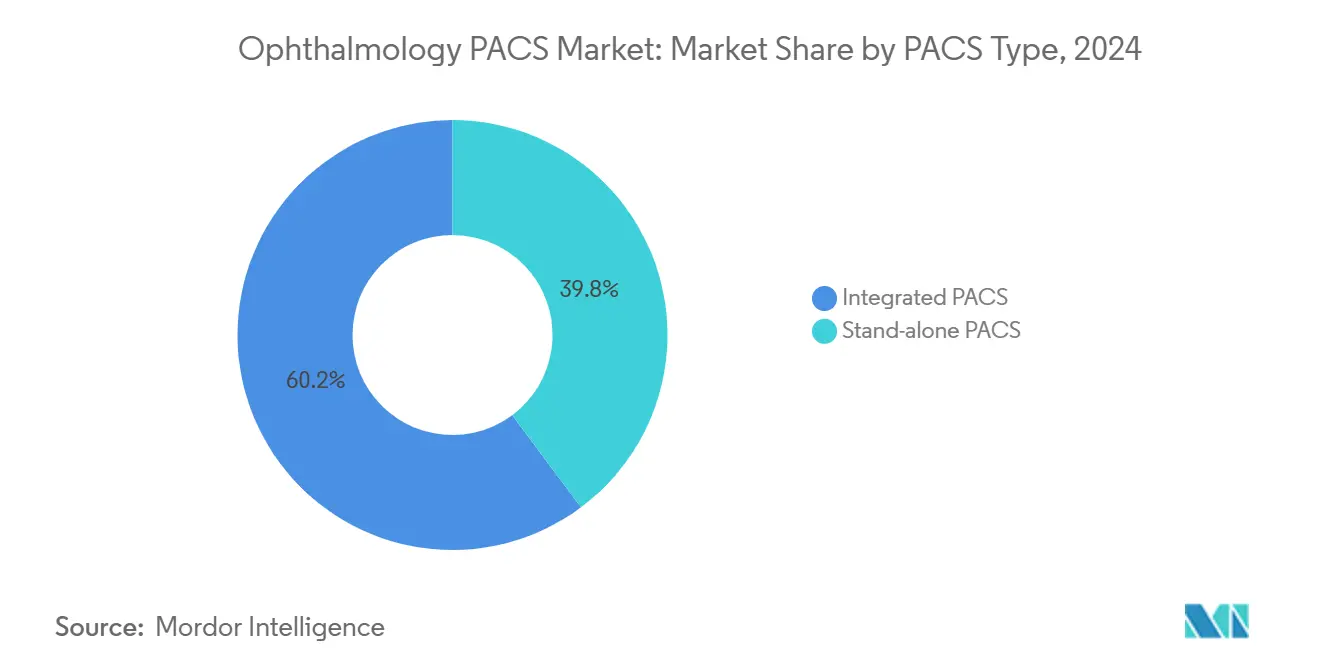
Note: Segment shares of all individual segments available upon report purchase
By Delivery Model: Cloud Migration Advances Despite On-premise Dominance
Although on-premise deployments held 58.95% of the ophthalmology PACS (picture archiving and communication system) market size in 2024, cloud systems are growing at 8.63% annually as bandwidth improves and CIOs seek subscription pricing. Multisite networks prefer cloud for unified governance, while independent clinics embrace it to avoid large hardware refreshes.
Performance bottlenecks persist where 10 Mbps links are unavailable, yet next-generation compression keeps imaging usable at 1 Mbps. Continuous AI model updates further push decision-makers toward cloud because new algorithms reach every location without local installs, reinforcing the long-term growth path.
By End User: ASC Growth Mirrors Outpatient Shift
Hospitals and integrated eye-care networks together controlled 61.84% share in 2024, reflecting their extensive modality fleets and training programs. Ambulatory surgical centers will post an 8.22% CAGR because cataract and retina surgeries continue migrating to outpatient sites where operating costs are lower and patient turnover is quicker.
ASC managers value browser-based PACS that support intraoperative view and postoperative quality checks from any workstation, shortening case cycle times. Emerging office-based surgery suites replicate this demand and prefer compact, subscription-priced archives that scale with case volume.

Note: Segment shares of all individual segments available upon report purchase
Geography Analysis
North America retained 42.45% of global revenue in 2024 as mature IT ecosystems, value-based reimbursement, and strict DICOM mandates under the Department of Veterans Affairs converged to sustain high capital investment cycles. Growth moderates, however, as many large networks already completed primary PACS installations and now prioritize incremental AI upgrades.
Asia Pacific is projected to add the largest incremental revenue at an 8.51% CAGR through 2030 due to large aging populations, higher diabetes incidence, and national e-health programs in China and India. Governments subsidize cloud infrastructure and tele-ophthalmology pilots, creating fertile ground for vendors delivering low-bandwidth solutions.
Europe shows steady adoption, aided by pan-regional interoperability initiatives and cloud approvals that satisfy GDPR. Philips recently expanded enterprise imaging services across the region, demonstrating that compliant-by-design platforms can overcome data-localization hurdles. The Middle East, Africa, and South America collectively represent an emerging opportunity pool; however, sporadic broadband and limited ophthalmologist density delay large-scale PACS rollouts. Vendors often pair philanthropic screening programs with commercial pilots to build reference sites that validate return on investment.
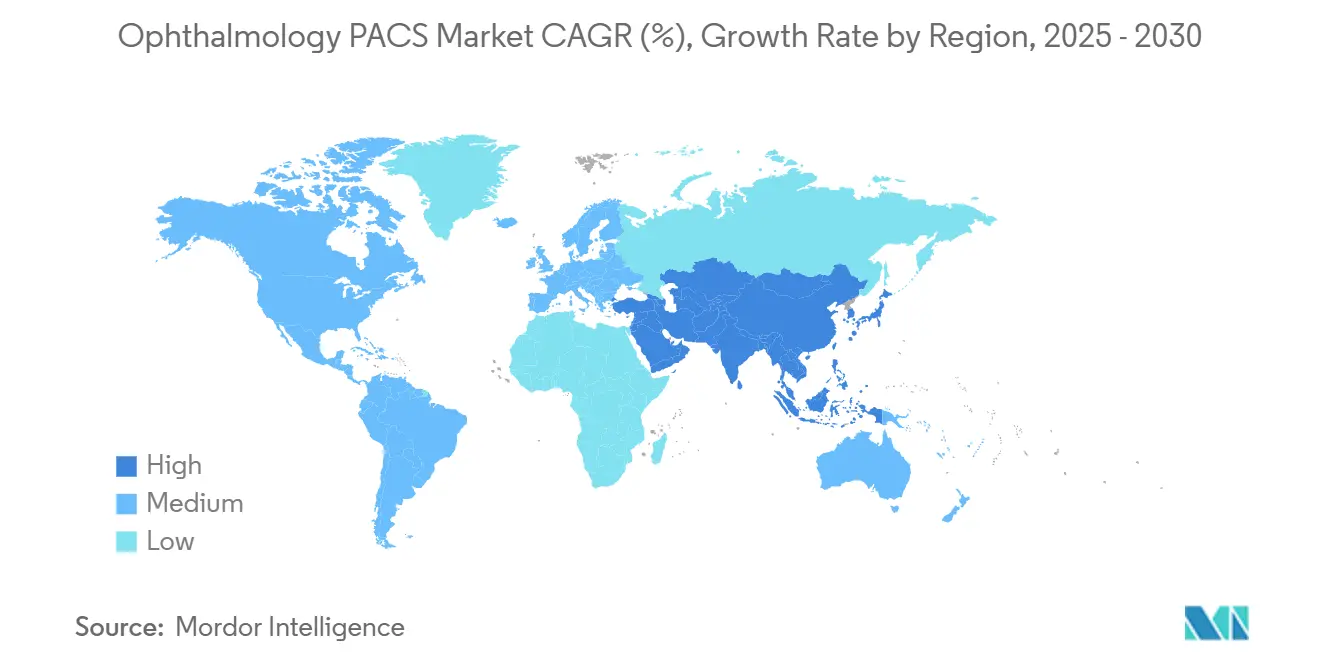
Competitive Landscape
The Ophthalmology PACS market features moderate fragmentation. Carl Zeiss Meditec, and Heidelberg Engineering bundle hardware with native archives, leveraging device integration to defend installed bases. Sectra, Visage Imaging, and RamSoft pursue cloud-first strategies that interoperate regardless of capture modality, appealing to multisite groups seeking vendor neutrality.
Acquisition activity illustrates convergence. Philips is strengthening cloud capacity via Amazon Web Services. Strategic aims center on embedding AI algorithms inside the PACS viewer so clinicians need no separate application.
Regulatory compliance and cybersecurity are emerging battlegrounds. Platforms certified under NIST SP 1800-24 reference architecture win preference in enterprise tenders. Companies able to show continuous monitoring, zero-trust network segmentation, and Software Bill of Materials transparency differentiate themselves as hospitals tighten procurement thresholds.
Ophthalmology PACS (Picture Archiving And Communication System) Industry Leaders
-
Agfa-Gevaert N.V.
-
Carl Zeiss Meditec AG
-
Heidelberg Engineering GmbH
-
Visbion Limited
-
IBM (Merge PACS)
- *Disclaimer: Major Players sorted in no particular order
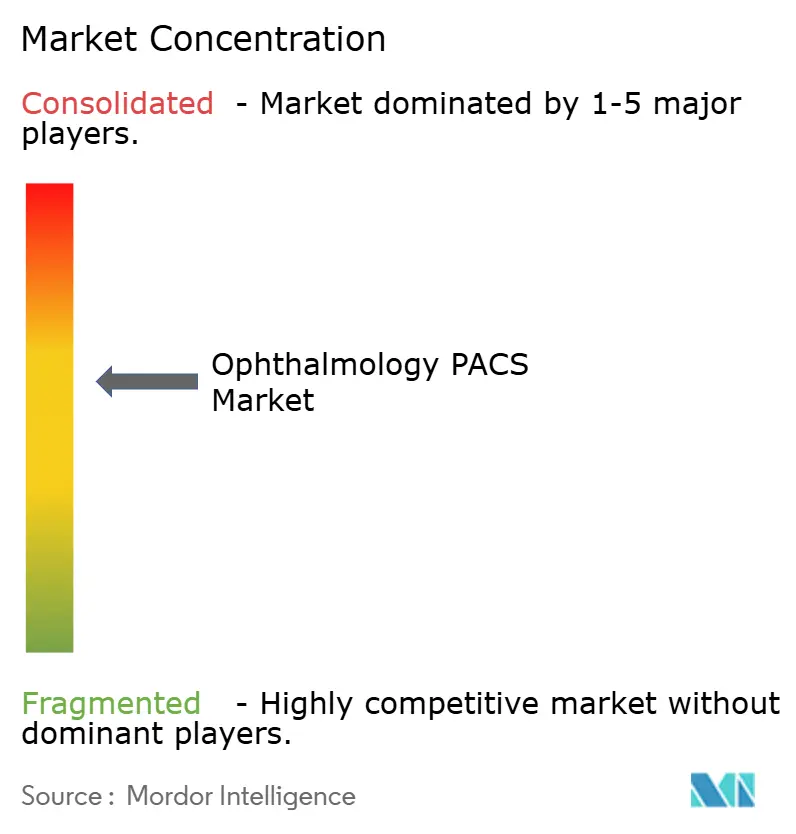
Recent Industry Developments
- April 2025: Children’s Health Ireland (CHI) inked a five-year deal with Sectra, a medical imaging and cybersecurity firm, to deploy a tailored ophthalmology PACS.
- March 2024: INFINITT introduced a browser-based Ophthalmology PACS featuring an HTML5 viewer that requires zero workstation downloads, showcased at HIMSS24 (Healthcare Information and Management Systems (HIMSS24).
Research Methodology Framework and Report Scope
Market Definitions and Key Coverage
According to Mordor Intelligence, the ophthalmology PACS market covers all software-centric picture archiving and communication systems purpose-built for eye-care imaging, fundus photography, OCT, angiography, and related modalities sold on a license, subscription, or bundled hardware basis to hospitals, eye-care networks, and ambulatory surgery centers worldwide. These platforms must handle DICOM storage, remote retrieval, and workflow orchestration that is specific to ophthalmic examinations.
Scope exclusion: solutions limited to generic image viewers, enterprise VNAs not customized for eye care, and stand-alone service contracts without an archival module are out of scope.
Segmentation Overview
- By PACS Type
- Integrated PACS
- Stand-alone PACS
- By Delivery Model
- Cloud-based
- On-premise
- By End User
- Hospitals and Eye-care Networks
- Ambulatory Surgical Centres
- Specialty Clinics / Solo Practices
- By Geography
- North America
- United States
- Canada
- Mexico
- Europe
- Germany
- United Kingdom
- France
- Italy
- Spain
- Rest of Europe
- Asia Pacific
- China
- Japan
- India
- Australia
- South Korea
- Rest of Asia Pacific
- Middle East and Africa
- GCC
- South Africa
- Rest of Middle East and Africa
- South America
- Brazil
- Argentina
- Rest of South America
- North America
Detailed Research Methodology and Data Validation
Primary Research
We interviewed hospital CIOs, imaging IT directors, ophthalmologists, and product managers across North America, Europe, Asia-Pacific, and the Gulf to test price corridors, typical workstation ratios, cloud migration pace, and renewal cycles. Their ground feedback fills data gaps, validates desk findings, and guides assumption tweaking before numbers are locked.
Desk Research
Our analysts first map the addressable universe through open datasets such as WHO Vision Atlas, the US Medicare Part B ophthalmology claims files, OECD Health Statistics, EU EUDAMED device listings, and trade data from UN Comtrade that tags OCT and fundus camera exports. Company 10-Ks, FDA 510(k) summaries, major eye-care association fact sheets, and journal papers in Investigative Ophthalmology & Visual Science sharpen adoption benchmarks.
Paid repositories, including D&B Hoovers for vendor revenue splits and Dow Jones Factiva for contract disclosures, help us verify customer counts, ASP trends, and regional roll-outs. Many additional public and subscription sources were also reviewed to complete background quantification and sanity checks.
Market-Sizing & Forecasting
The model begins with a top-down build: installed eye-care imaging suites by country are multiplied by PACS penetration rates and calibrated average annual license value. Results are then cross-checked through selective bottom-up roll-ups of vendor revenue, channel checks, and sampled ASP x unit shipments. Key variables like cataract and diabetic retinopathy procedure counts, ophthalmologist density, cloud share shift, average five-year replacement cycle, and inflation-adjusted software pricing drive both historical reconstruction and outlook. An ARIMA forecast, stress-tested with scenario envelopes agreed during expert calls, projects demand through 2030 while gap-handling logic caps any unexplained variance at 5 percent of base.
Data Validation & Update Cycle
Outputs pass multi-layer variance scans versus import data, hospital IT capex, and vendor earnings. Senior reviewers challenge anomalies before release. Our dashboards trigger a refresh when acquisitions, major regulatory changes, or price swings move the market; otherwise, figures are revisited annually and a fresh analyst pass is run just before delivery.
Why Mordor's Ophthalmology PACS Baseline Stands Firm
Published estimates often differ because firms pick dissimilar product mixes, price bases, and refresh cadences.
Key gap drivers include inclusion of generic VNAs, omission of small Asia-Pacific clinics, use of shipment-only formulas, or rolling forward outdated ASPs. By selecting only ophthalmology-tuned PACS, capturing service plus upgrade revenue, and reconciling hospital budgets with vendor splits, Mordor delivers a balanced, audit-ready baseline.
Benchmark comparison
| Market Size | Anonymized source | Primary gap driver |
|---|---|---|
| USD 177.71 M (2025) | Mordor Intelligence | - |
| USD 175.90 M (2025) | Global Consultancy A | Excludes cloud subscriptions from Asia-Pacific clinics |
| USD 184.40 M (2025) | Trade Journal B | Relies on device shipment value, ignores annual service revenue |
In short, our disciplined scope choices, dual-path modeling, and continuous validation give decision-makers a dependable reference point, free from hidden inclusions or aged assumptions.
Key Questions Answered in the Report
Why are integrated ophthalmic PACS platforms gaining preference over stand-alone systems?
Hospitals and multi-site eye-care networks favor integrated solutions because they remove vendor fragmentation, streamline multi-modality workflows, and better support AI analytics, reducing both clinical hand-offs and IT complexity.
What strategic benefit does cloud deployment offer ophthalmology practices?
Cloud PACS lowers up-front capital, speeds access to new AI modules, and enables anytime image review, giving smaller practices enterprise-grade capability without maintaining local hardware.
How are ambulatory surgical centers shaping demand for ophthalmic PACS?
The outpatient shift in cataract and retina procedures pulls demand toward browser-based PACS that support intraoperative viewing and quick postoperative review, aligning with ASCs’ need for fast case turnover.
Which technology feature most influences buying decisions for new PACS installations?
Native AI tools—such as automated image quality checks and retinal layer segmentation—have become decisive, as administrators seek productivity gains and consistent diagnostic accuracy.
What is the primary security concern slowing PACS adoption in regulated regions?
Health systems worry about ransomware and data-sovereignty compliance, so vendors that demonstrate zero-trust architectures and full audit trails gain procurement advantage.
How does tele-ophthalmology expansion affect PACS requirements?
With home-based OCT devices and virtual consultations generating distributed data, buyers demand cloud-native archives that can ingest images from remote sites while maintaining diagnostic fidelity.
Page last updated on:
